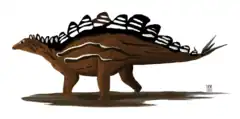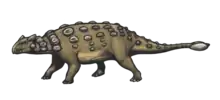| Acantholipan Temporal range: Late Cretaceous, | |
|---|---|
| Scientific classification | |
| Domain: | Eukaryota |
| Kingdom: | Animalia |
| Phylum: | Chordata |
| Clade: | Dinosauria |
| Clade: | †Ornithischia |
| Clade: | †Thyreophora |
| Suborder: | †Ankylosauria |
| Family: | †Nodosauridae |
| Subfamily: | †Nodosaurinae |
| Genus: | †Acantholipan Rivera-Sylva et al., 2018 |
| Type species | |
| †Acantholipan gonzalezi Rivera-Sylva et al. 2018 | |
Acantholipan is a genus of herbivorous nodosaurid dinosaur from Mexico from the early Santonian age of the Late Cretaceous. It includes one species, Acantholipan gonzalezi.[1]
Discovery and naming
In the north of Mexico, fragmentary fossils have been found of nodosaurids. A partial skeleton excavated at Los Primos near San Miguel in Coahuila, was described in 2011. When Rivera-Sylva and colleagues reported the discovery of this specimen, CPC 272, they initially considered it too fragmentary to name.[2] Later it was judged that the remains were sufficiently distinct to be given a binomial name.
In 2018, the type species Acantholipan gonzalezi was named by Héctor Eduardo Rivera-Sylva, Eberhard Frey, Wolfgang Stinnesbeck, Gerardo Carbot-Chanona, Iván Erick Sanchez-Uribe and José Rubén Guzmán-Gutiárrez. The generic name combines a Greek akanthos, "spine", with lipan, the usual Spanish designation of the Lépai-Ndé, the "Gray People", a tribe of the Apache inhabiting the area of the find. The specific name honours the Mexican paleontologist Arturo Homero González-González, the chairman of the Museo del Desierto at Saltillo. Acantholipan is the first ankylosaurian species named from Mexico.[1]
The holotype specimen, CPC 272, was found alongside another nodosaur, CPC 273, in a marine layer of the Pen Formation and dates from the Santonian. It consists of partial skeleton lacking the skull. Its remains include a back vertebra, a tail vertebra, a piece of a rib, the underside of the left humerus, an upper left ulna, the underside of the left femur and a spike-like osteoderm probably from the posterior thorax.[2] The fossil is part of the Colección Paleontológica de Coahuila, Museo del Desierto, Saltillo.[1]
Classification
Acantholipan belongs to the Nodosaurinae and is the sister taxon to Nodosaurus.[1] The 2018 phylogenetic analysis of Rivera-Sylva and colleagues is below:[1]
| Nodosauridae |
| |||||||||||||||||||||||||||||||||||||||||||||||||||||||||||||||||||||||||||||||||||||||||||||||||||||||||||||||||||||||||||||||||||||||||||||||||||||||||
See also
References
- 1 2 3 4 5 Rivera-Sylva, H.E.; Frey, E.; Stinnesbeck, W.; Carbot-Chanona, G.; Sanchez-Uribe, I.E.; Guzmán-Gutiérrez, J.R. (2018). "Paleodiversity of Late Cretaceous Ankylosauria from Mexico and their phylogenetic significance". Swiss Journal of Palaeontology. 137 (1): 83–93. doi:10.1007/s13358-018-0153-1. ISSN 1664-2376. S2CID 134924657.
- 1 2 Rivera-Sylva, H.E.; Carpenter, K.; Aranda-Manteca, F.J. (2011). "Late Cretaceous Nodosaurids (Ankylosauria: Ornithischia) from Mexico" (PDF). Revista Mexicana de Ciencias Geológicas. Querétaro, Mexico: Universidad Nacional Autónoma de Mexico. 28 (3): 371–378.

